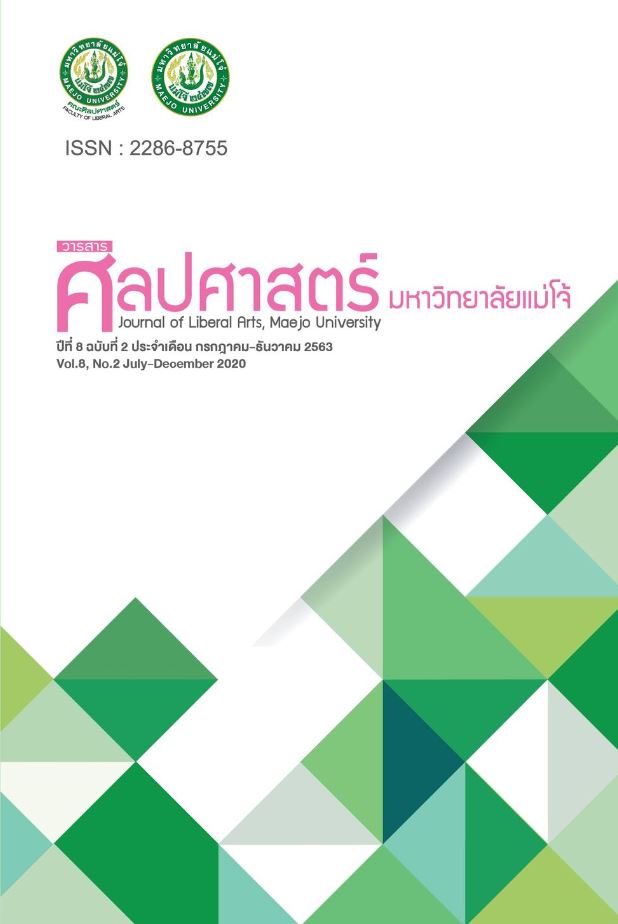การวิจัยเชิงทดลองรูปแบบพัฒนาการระบบคลังคำในใจของภาษาจีนในฐานะภาษาที่สองของนักศึกษาไทย
Main Article Content
บทคัดย่อ
งานวิจัยนี้มีวัตถุประสงค์เพื่อ 1) สรุปรูปแบบพัฒนาการของโครงสร้างระบบคำภาษาจีนในคลังคำใน 2) อธิบายเส้นทางพัฒนาการความเปลี่ยนแปลงในการเรียนคำศัพท์ภาษาจีนของนักศึกษาไทยได้ชัดเจนและแม่นยำยิ่งขึ้น 3) เสนอแนะแนวทางการสอนคำศัพท์ภาษาจีนสำหรับนักศึกษาไทยได้อย่างมีประสิทธิภาพ กลุ่มผู้เข้าร่วมการทดสอบคือ นักศึกษาระดับชั้นปีที่ 2-4 ที่ศึกษาในปี 2558-2560 ในสาขาวิชาการสอนภาษาจีน สำนักวิชาจีนวิทยา มหาวิทยาลัยแม่ฟ้าหลวง โดยสุ่มแบบเจาะจงทั้งหมด 240 คน วิธีดำเนินการวิจัยคือ แบบทดสอบการเชื่อมโยงคำอิสระและวิธีการสัมภาษณ์ ผลการวิจัยพบว่า 1) ระบบคำภาษาจีนในคลังคำในใจของนักศึกษาไทยมีการตอบสนองแบบต่อเนื่องเป็นหลัก และค่อยๆ เปลี่ยนเป็นการตอบสนองแบบประเภทเดียวกัน 2) ระบบคำภาษาจีนในคลังคำในใจของนักศึกษาไทยมีการตอบสนองประเภทเชื่อมโยงทางความหมายมากที่สุด แต่เกิดสภาวะการหยุดชะงักแบบคงที่ชั่วคราว ทั้งนี้ลำดับการเรียนรู้ความหมายคำศัพท์ยังอยู่ในระยะแทรกสื่อภาษาแม่ 3) เส้นทางการเปลี่ยนแปลงรูปแบบประเภทการตอบสนองระบบคำภาษาจีนในคลังคำในใจของนักศึกษาไทยนั้นเปลี่ยนจากประเภทไม่เชื่อมโยงทางความหมายเป็นเชื่อมโยงทางความหมาย แต่เส้นทางการพัฒนานั้นได้ครอบคลุมถึงรูปแบบเส้นทแยง แบบ U หรือ แสดงให้เห็นว่าลำดับการเรียนรู้คำศัพท์ภาษาจีนของกลุ่มผู้เข้าร่วมทดสอบไม่ได้เป็นไปตามเส้นทางการพัฒนาในแบบแนวทแยงเท่านั้น ยังมีแนวโน้มทิศทางการพัฒนาแบบ U หรือ ∩
Article Details
เอกสารอ้างอิง
Entwisle, D. R. (1966). Word Association of Young Children. Baltimore: Johns Hopkins University Press.
Fitzpatrick, T. (2007). Habits and Rabbits: Word Associations and the L2 Lexicon. Euro SLA Yearbook, 6(1), 121-145.
Fu, Y. P & Cui, Y. Y & Chen, H. (2009). A Longitudinal Study of the Developmental Pattern of SL Mental Lexicon. Foreign Language and Literature Studies, 1, 18-25+74.
Gao, L. Q & Meng, L & Liu, Z. J. (2003). An Experimental Study of Japanese-Chinese Bilingual’s Mental Lexicon Representation Structure. Contemporary Linguistics, 5(2),120-132.
Gong, S. L. (2010). A Study on Mental Lexicon of TCSL in Primary Stage. Anhui Literature, 6, 195-196.
Hu, Y. K. (2016). The Characteristics of the Mental Dictionary Research of Korean Chinese Language Learners in South Korea: A Case of the Students in the Confucius Institute at Hankuk University of Foreign Studies. Master’s Thesis. Beijing Foreign Studies University.
Jiang, N. (2000). Lexical representation and development in a second language. Applied Linguistics, 21(1), 47-77.
Li, G. L & Jiang, W. Y. (2015). On the Features of Lexical Network in Chinese as a Second Language: A Case from Chinese Learners in Australia. TCSOL Studies, 4, 22-29.
Li, J. (2003). An Experiment Study of Lexicon Access on Japanese Learners of Chinese. Master’s Thesis. Beijing Language and Culture University.
Li, X. S & Wang, W. Y. (2016). A Comparative Study of word association and Concreteness Effect of English and Chinese Mental Lexicon. Foreign Language World, 5, 70-78.
Lin, C. J & Nisareen, W. (2018). A Longitudinal Case Study on Chinese Character Writing Errors by Thai University Students in Different Learning Stages. Journal of International Studies, 8(1), 196-226.
Liu, Y. L & Ma, J. F. (2010). The Graded Chinese Syllables, Characters and Words for the Application of Teaching Chinese to the Speakers of Other languages. Beijing: Beijing Language and Culture University Press.
Maréchal, C. (1995). The Bilingual Lexicon: Study of French and English Word Association Responses of Advanced Learners of French. M. Phil. Dissertation. University of Dublin.
Meara, P. (1983). Word Associations in a Foreign Language, Nottingham Linguistic Circular, 11, 28-38.
Namei, S. (2004). Bilingual Lexical Development: a Persian-Swedish Word Association Study. International Journal of Applied Linguistics, 14, 363-386.
Nissen, H. B. & Henriksen, B. (2006). Word Class Influence on Word Association Test Results. International Journal of Applied Linguistics, 16, 389-408.
O'Gorman, E. (1996). An Investigation of the Mental Lexicon of Second Language Learners. TEANGA: The Irish Year Book of Applied Linguistics, 16, 15- 31.
Pan, W. G. (1997). Chinese-English Comparison Outline. Beijing: Beijing Language and Culture University Press.
Schmitt, N. (1998). Tracking the Incremental Acquisition of Second Language Vocabulary: A Longitudinal Study. Language Learning, 48, 281-317.
Selinker, L. (1972). Interlanguage. IRAL, 10, 201-231.
Selinker, L. & Lakshmanan, U. (1992). Language Transfer and Fossilization: The Multiple Effects Principle. In S. Gass, & L. Selinker (Eds.), Language Transfer in Language Learning (Rev. ed., pp.197-216). Philadelphia: Benjamins.
Söderman, T. (1993). Word Associations of Foreign Language Learners and Native Speakers: Different Response Types and Their Relevance to Lexical Development. In B. Hammerberg (Ed.), Problems, Process and Product in Language Learning (pp. 157–169). Abo, Finland: Abo Academic.
Song, L. (2018). The Study of Mental Lexicon Structure of Chinese EFL Learners. Master’s Thesis. Zhengzhou University.
Wang, C. C. (2014). Research on Construction of Chinese Mental Lexicon of Japanese Students Residing in China and Vocabulary Teaching. Master’s Thesis. Liaoning University.
Wang, Z. J & Hao, Y. X. (2014). An Experimental Study on the Development of Mental Lexicon by CSL Learners in Native Language Environment. Language Teaching and Linguistic Studies, 1, 29-37.
Wichat, B. (2012). The Thai Lexical System of 2nd Language Learners: A Case Study of Laotian and Korean Students, Journal of Letters, 41 (1): 123-150. (In Thai)
Wolter, B. (2001). Comparing the L1 and L2 Mental Lexicon. Studies in Second Language Acquisition, 23, 41-69.
Wu, S. N. (2017). The Organization and Affecting Factors of Chinese as L2 Mental Lexicon of Korean Students. TCSOL Studies, 4, 32-39.
Xing, H. B. (2009). A Connectionist Research Framework of Second Language Vocabulary Acquisition. Language Teaching and Linguistic Studies, 5, 66-73.
Yang, J. Z. (2015). Hanyu Jiaocheng (revised edition). Beijing: Beijing Language and Culture University Press.
Zhang, J. Q & Chen, D. G. (2018). An Empirical Study on Chinese College Students’ Associative Reaction to Chinese Mental Lexicon. Applied Linguistics, 4, 75-84.
Zhang, P. (2010a). Choice of Prompt Words and Classification of Responses in Word Association Tests: A Re-examination. Journal of PLA University of Foreign Languages, 33(1),41-45.
Zhang, P. (2010b). A Comparative Study of Word Association Patterns in Chinese EFL Learners Mental Lexicon. Foreign Language Teaching and Research, 42(1),11-12.
Zhang, S. J. (2005). Investigating Connections in L2 Mental Lexicon with Word Association Tests. Journal of PLA University of Foreign Languages, 28(2), 52-57.
Zou, X. Q. (2011). An Experimental Study of Vietnamese-Chinese Bilingual’s Mental Lexicon Representation Structure. Data of Culture and Education, 9, 63-65.

